Remote Sensing, Archaeological, and Geophysical Data to Study the Terramare Settlements: The Case Study of Fondo Paviani (Northern Italy)
Abstract
1. Introduction
Study Site Background
2. Materials and Methods
2.1. Geomorphological Setting
2.2. Aerial Photograph Interpretation
2.3. LIDAR
2.4. Stratigraphic Analysis
2.5. Electrical Resistivity Tomography (ERT)
2.6. Frequency Domain Electromagnetic (FDEM)
The Nonlinear Forward Problem and the Inversion Procedure
3. Results
4. Discussion
5. Conclusions
Author Contributions
Funding
Acknowledgments
Conflicts of Interest
References
- Clark, A.J. Seeing Beneath the Soil: Prospecting Methods in Archaeology; BT Batsford Ltd.: London, UK, 1990; ISBN 0-203-16498-9. [Google Scholar]
- Schmidt, A. Geophysical Data in Archaeology: A Guide to Good Practice; Oxbow Books Ltd.: Oxford, UK, 2001; ISBN 9781900188715. [Google Scholar]
- Kvamme, K.L. Geophysical surveys as landscape archaeology. Am. Antiq. 2003, 68, 435–457. [Google Scholar] [CrossRef]
- Witten, A. Handbook of Geophysics in Archaeology; Routledge, Taylor & Francis Group: New York, NY, USA, 2014; ISBN 978-1-904768-60-9. [Google Scholar]
- Campana, S.; Piro, S. Seeing the Unseen. Geophysics and Landscape Archaeology; Taylor & Francis Group: London, UK, 2009; ISBN 978-0-415-44721-8. [Google Scholar]
- Sala, R.; Garcia, E.; Tamba, R. Archaeological Geophysics—From Basics to New Perspectives. In Archaeology. New Approaches in Theory and Techniques; Ollich-Castanyer, I., Ed.; IntechOpen Ltd.: London, UK, 2012; pp. 133–166. ISBN 978-953-51-0590-9. [Google Scholar]
- Noel, M. Multielectrode Resistivity Tomography for Imaging Archaeology. In Geoprospection in the Archaeological Landscape; Spoerry, P., Ed.; Oxbow Books Ltd.: Oxford, UK, 1992; pp. 89–99. ISBN 9780946897421. [Google Scholar]
- Walker, A.R. Multiplexed Resistivity Survey at the Roman Town of Wroxeter. Archaeol. Prospect. 2000, 7, 119–132. [Google Scholar] [CrossRef]
- Thacker, P.T.; Ellwood, B.B. Detecting palaeolithic activity areas through electrical resistivity survey: An assessment from Vale de Obidos, Portugal. J. Archaeol. Sci. 2002, 29, 563–570. [Google Scholar] [CrossRef]
- Papadopoulos, N.G.; Tsourlos, P.; Tsokas, G.N.; Sarris, A. Two-dimensional and three-dimensional resistivity imaging in archaeological site investigation. Archaeol. Prospect. 2006, 13, 163–181. [Google Scholar] [CrossRef]
- Burkart, U.; Günther, T.; Rücker, C. Electrical resistivity tomography methods for archaeological prospection. In Layer of Perception, Proceedings of the 35th International Conference on Computer Applications and Quantitative Methods in Archaeology (CAA), Berlin, Germany, 2–6 April 2007; Posluschny, A., Lambers, K., Herzog, I., Eds.; Dr. Rudolf Habelt GmbH: Bonn, Germany, 2008. [Google Scholar]
- Tsokas, G.N.; Tsourlos, P.I.; Stampolidis, A.; Katsonopoulou, D.; Soter, S. Tracing a major Roman road in the area of Ancient Helike by resistivity tomography. Archaeol. Prospect. 2009, 16, 251–266. [Google Scholar] [CrossRef]
- Mol, L.; Preston, P. The writing’s in thewall: A review of new preliminary applications of electrical resistivity tomography within archaeology. Archaeometry 2010, 52, 1079–1095. [Google Scholar]
- Callistus, N.; Akwasi, A.; Danuor, S.; Reginald, N. Delineation of graves using electrical resistivity tomography. J. Appl. Geophys. 2016, 126, 138–147. [Google Scholar]
- Fischanger, F.; Catanzariti, G.; Comina, C.; Sambuelli, L.; Morelli, G.; Barsuglia, F.; Ellaithy, A.; Porcelli, F. Geophysical anomalies detected by electrical resistivity tomography in the area surrounding Tutankhamun’ tomb. J. Cult. Herit. 2018, 36, 63–71. [Google Scholar] [CrossRef]
- Papadopoulos, N.; Apostolos, S.; Myeong-Jong, Y.; Jung-Ho, K. Urban archaeological investigations using surface 3D Ground Penetrating Radar and Electrical Resistivity Tomography methods. Explor. Geophys. 2009, 40, 56–68. [Google Scholar] [CrossRef]
- Argote-Espino, D.L.; Lopez-García, P.A.; Tejero-Andrade, A. 3D-ERT geophysical prospecting for the investigation of two terraces of an archaeological site northeast of Tlaxcala state, Mexico. J. Archaeol. Sci. Rep. 2016, 8, 406–415. [Google Scholar] [CrossRef]
- Fernandez, J.P.; Rubio-Melendi, D.; Quirós Castillo, J.A.; González Quirós, A.; Cimadevilla-Fuente, D. Combined GPR and ERT exploratory geophysical survey of the Medieval Village of Pancorbo Castle (Burgos, Spain). J. Appl. Geophys. 2017, 144, 86–93. [Google Scholar] [CrossRef]
- Casas, A.; Cosentino, P.L.; Fiandaca, G.; Himi, M.; Macias, J.M.; Martorana, R.; Muñoz, A.; Rivero, L.; Sala, R.; Teixell, I. Non-invasive Geophysical Surveys in Search of the Roman Temple of Augustus Under the Cathedral of Tarragona (Catalonia, Spain): A Case Study. Surv. Geophys. 2018, 39, 1107–1124. [Google Scholar] [CrossRef]
- Deiana, R.; Bonetto, J.; Mazzariol, A. Integrated Electrical Resistivity Tomography and Ground Penetrating Radar Measurements Applied to Tomb Detection. Surv. Geophys. 2018, 39, 1081–1105. [Google Scholar] [CrossRef]
- Monik, M.; Lend’áková, Z.; Ibáñez, J.; MuñizÁlvarez, J.; Borrell, F.; Iriarte, E.; Teira, L.; Kuda, F. Revealing early villages—Pseudo-3D E.R.T. geophysical survey at the pre-pottery Neolithic site of Kharaysin, Jordan. Archaeol. Prospect. 2018, 25, 339–346. [Google Scholar] [CrossRef]
- Kenady, S.L.; Lowe, K.M.; Ridd, P.V.; Ulm, S. Creating volume estimates for buried shell deposits: A comparative experimental case study using ground-penetrating radar (GPR) and electrical resistivity under varying soil conditions. Archaeol. Prospect. 2018, 25, 121–136. [Google Scholar] [CrossRef]
- McNeill, J.D. Electrical Conductivity of Soils and Rocks; Technical Note TN-5; Geonics Limited: Mississauga, ON, Canada, 1980. [Google Scholar]
- Baines, D.; Derald, G.S.; Froese, D.G.; Bauman, P.; Grant, N. Electrical resistivity ground imaging (ERGI): A new tool for mapping the lithology and geometry of channel–Belts and valley–Fills. Sedimentology 2002, 49, 441–449. [Google Scholar] [CrossRef]
- Dabas, M.; Tabbagh, A. A. A comparison of EMI. and DC methods used in soil mapping—Theoretical considerations for precision agriculture. In Precision Agriculture; Stafford, J., Werner, A., Eds.; Wageningen Academic Publishers: Wageningen, The Netherlands, 2003; pp. 121–127. ISBN 978-90-76998-21-3. [Google Scholar]
- Corwin, D.L.; Lesch, S.M. Apparent soil electrical conductivity measurements in agriculture. Comput. Electron. Agric. 2005, 46, 11–43. [Google Scholar] [CrossRef]
- Maillet, G.; Rizzo, E.; Vella, C. High Resolution Electrical Resistivity Tomography (ERT) in a Transition Zone Environment: Application for Detailed Internal Architecture and Infilling Processes Study of a Rhône River Paleo-channel. Mar. Geophys. Res. 2005, 26, 317–328. [Google Scholar] [CrossRef]
- Bersezio, R.; Giudici, M.; Mele, M. Combining sedimentological and geophysical data for high-resolution 3-D mapping of fluvial architectural elements in the Quaternary Po plain (Italy). Sediment. Geol. 2007, 202, 230–248. [Google Scholar] [CrossRef]
- Zhu, Q.; Lin, H.; Doolittle, J. Repeated electromagnetic induction surveys for improved soil mapping in an agricultural landscape. Soil Sci. Soc. Am. J. 2010, 74, 1763–1774. [Google Scholar] [CrossRef]
- Scapozza, C.; Laigre, L. The contribution of Electrical Resistivity Tomography (ERT) in Alpine dynamics geomorphology: Case studies from the Swiss Alps. Géomorphol. Relief Process. Environ. 2014, 20, 27–42. [Google Scholar] [CrossRef]
- Van Dam, R.L. Landform characterization using geophysics—Recent advances, applications, and emerging tools. Geomorphology 2012, 137, 57–73. [Google Scholar] [CrossRef]
- Fidolini, F.; Ghinassi, M.; Aldinucci, M.; Billi, P.; Boaga, J.; Deiana, R.; Brivio, L. Fault-sourced alluvial fans and their interaction with axial fluvial drainage: An example from the Plio-Pleistocene Upper Valdarno Basin (Tuscany, Italy). Sediment. Geol. 2013, 289, 19–39. [Google Scholar] [CrossRef]
- Papadopoulos, N.G.; Sarris, A.; Parkinson, W.A.; Gyucha, A.; Yerkes, R.W.; Duffy, P.R.; Tsourlos, P. Electrical Resistivity Tomography for the Modelling of Cultural Deposits and Geomophological Landscapes at Neolithic Sites: A Case Study from Southeastern Hungary. Archaeol. Prospect. 2014, 21, 169–183. [Google Scholar] [CrossRef]
- Bianchi, V.; Ghinassi, M.; Aldinucci, M.; Boaga, J.; Brogi, A.; Deiana, R. Tectonically driven deposition and landscape evolution within upland incised valleys: Ambra Valley fill, Pliocene-Pleistocene, Tuscany, Italy. Sedimentology 2015, 62, 897–927. [Google Scholar] [CrossRef]
- Deiana, R.; Dieni, I.; Massari, F.; Perri, M.T.; Rossi, M.; Brovelli, A. A multidisciplinary study of deformation of the basaltic cover over fine-grained valley fills: A case study from Eastern Sardinia, Italy. Int. J. Earth Sci. 2016, 105, 1245–1255. [Google Scholar] [CrossRef]
- Van Der Kruk, J.; Von Hebel, C.; Brogi, C.; Kaufmann, M.S.; Tan, X.; Weihermüller, L.; Huisman, J.A.; Vereecken, H.; Mester, A. Calibration, Inversion, and Applications of Multiconfiguration Electromagnetic Induction for Agricultural Top- and Subsoil Characterization. S.E.G.; Technical Program Expanded Abstracts; Society of Exploration Geophysicists: Tulsa, OK, USA, 2018; pp. 2546–2550. [Google Scholar]
- Khan, I.; Sinha, R. Discovering ‘buried’ channels of the Palaeo-Yamuna river in NW India using geophysical evidence: Implications for major drainage reorganization and linkage to the Harappan Civilization. J. Appl. Geophys. 2019, 167, 128–139. [Google Scholar] [CrossRef]
- Lasaponara, R.; Coluzzi, R.; Gizzi, F.T.; Masini, N. On the LiDAR contribution for the archaeological and geomorphological study of a deserted medieval village in Southern Italy. J. Geophys. Eng. 2010, 7, 155–163. [Google Scholar] [CrossRef]
- Alexakis, D.; Agapiou, A.; Hadjimitsis, D.; Sarris, A. Remote Sensing Applications in Archaeological Research. In Remote Sensing; Escalante, B., Ed.; IntechOpen Ltd.: London, UK, 2012; pp. 435–462. ISBN 978-953-51-0651-7. [Google Scholar]
- Kasprzak, M.; Traczyk, A. LiDAR and 2D Electrical Resistivity Tomography as a Supplement of Geomorphological Investigations in Urban Areas: A Case Study from the City of Wrocław (SW Poland). Pure Appl. Geophys. 2014, 171, 835–855. [Google Scholar] [CrossRef]
- Elmahdy, S.; Mohamed, M.M. Remote sensing and geophysical survey applications for delineating near surface paleochannels and shallow aquifer in the United Arab Emirates. Geocarto Int. 2015, 30, 723–736. [Google Scholar] [CrossRef]
- Křivánek, R. Comparison Study to the Use of Geophysical Methods at Archaeological Sites Observed by Various Remote Sensing Techniques in the Czech Republic. Geosciences 2017, 7, 81. [Google Scholar] [CrossRef]
- Cozzolino, M.; Longo, F.; Pizzano, N.; Rizzo, M.L.; Voza, O.; Amato, V. A Multidisciplinary Approach to the Study of the Temple of Athena in Poseidonia-Paestum (Southern Italy): New Geomorphological, Geophysical and Archaeological Data. Geosciences 2019, 9, 324. [Google Scholar] [CrossRef]
- Monterroso-Checa, A.; Teixidó, T.; Gasparini, M.; Peña, J.A.; Rodero, S.; Moreno, J.C.; Morena, J.A. Use of Remote Sensing, Geophysical Techniques and Archaeological Excavations to Define the Roman Amphitheater of Torreparedones (Córdoba, Spain). Remote Sens. 2019, 11, 2937. [Google Scholar] [CrossRef]
- Bernabò Brea, M.; Mutti, A. “…Le Terramare di scavano per concimare i prati…”. La nascita dell’archeologia preistorica a Parma nella seconda metà dell’Ottocento; Silva: Parma, Italy, 1994; ISBN 978-8877650474. [Google Scholar]
- Bernabò Brea, M.; Cardarelli, A.; Cremaschi, M. Le Terramare, La più Antica Civiltà Padana, 1997; Catalogo della Mostra: Milano, Italy, 1994. [Google Scholar]
- Available online: https://www.tes.com/lessons/u_uWq0a1bZw7Ew/i-popoli-italici-prima-dei-romani (accessed on 15 May 2020).
- Peroni, R. Introduzione Alla Protostoria Italiana; Editori Laterza: Roma-Bari, Italy, 1994. [Google Scholar]
- Peroni, R. L’Italia Alle Soglie Della Storia; Editori Laterza: Roma-Bari, Italy, 1996. [Google Scholar]
- Cardarelli, A.; Vanzetti, A. L’approccio di Renato Peroni allo studio delle società protostoriche dalla fine degli anni ’60 del XX secolo. In 150 anni di Preistoria e Protostoria in Italia, “Studi di Preistoria e Protostoria” 1; Guidi, A., Ed.; Istituto Italiano di Preistoria e Protostoria: Firenze, Italy, 2014; ISBN 978-8860450555. [Google Scholar]
- Cardarelli, A. The collapse of the Terramare Culture and growth of new economic and social systems during the Late Bronze Age in Italy. Sci. dell’Antichità 2010, 15, 449–520. [Google Scholar]
- Cupitò, M.; Leonardi, G. Il Veneto tra Bronzo antico e Bronzo recente. In Preistoria e Protostoria del Veneto; Leonardi, G., Tinè, V., Eds.; Studi di Preistoria e Protostoria 2; Istituto Italiano di Preistoria e Protostoria: Firenze, Italy, 2015; pp. 201–240. [Google Scholar]
- Mele, M.; Cremaschi, M.; Giudici, M.; Bassi, A.; Pizzi, C.; Lozej, A. Reconstructing Hidden Landscapes. DC and EM Prospections in the Terramara Santa Rosa (Bronze Age Settlement—Northern Italy). Geophysical Research Abstracts; EGU: Vienna, Austria, 2012; Volume 14, p. 5269. [Google Scholar]
- Mele, M.; Cremaschi, M.; Giudici, M.; Lozej, A.; Pizzi, C.; Bassi, A. The Terramare and the surrounding hydraulic structures: A geophysical survey of the Santa Rosa site at Poviglio (Bronze Age, Northern Italy). J. Archaeol. Sci. 2013, 40, 4648–4662. [Google Scholar] [CrossRef]
- Cupitò, M. Micenei in Italia settentrionale. In Le Grandi Vie Delle Civiltà. Relazioni e Scambi Fra Mediterraneo e il Centro Europa Dalla Preistoria Alla Romanità; Marzatico, F., Gebhard, R., Gleirscher, P., Eds.; Catalogo della Mostra, Trento, Castello del Buonconsiglio, 1 July–13 November 2011; Museo Castello Buonconsiglio: Milano, Italy, 2011; pp. 193–197. ISBN 978-8890090981. [Google Scholar]
- Cupitò, M.; Leonardi, G.; Dalla Longa, E.; Nicosia, C.; Balista, C.; Dal Corso, M.; Kirleis, W. Fondo Paviani (Legnago, Verona): Il central place della polity delle Valli Grandi Veronesi nella tarda Età del bronzo. Cronologia, aspetti culturali, evoluzione delle strutture e trasformazioni paleoambientali. In Preistoria e Protostoria del Veneto; Leonardi, G., Tiné, V., Eds.; Studi di Preistoria e Protostoria: Firenze, Italy, 2015; pp. 357–375. [Google Scholar]
- Bettelli, M.; Cupitò, M.; Levi, S.T.; Jones, R.; Leonardi, G. Tempi e modi della connessione tra mondo egeo e area padano-veneta. Una riconsiderazione della problematica alla luce delle nuove ceramiche di tipo miceneo di Fondo Paviani (Legnago, Verona). In Preistoria e Protostoria del Veneto; Leonardi, G., Tiné, V., Eds.; Studi di Preistoria e Protostoria: Firenze, Italy, 2015; pp. 377–387. [Google Scholar]
- Bettelli, M.; Cupitò, M.; Jones, R.; Leonardi, G.; Levi, S.T. The Po Plain, Adriatic and Eastern Mediterranean in the Late Bronze Age: Fact, fancy and plausibility. In Hesperos. Aegean Seen from the West, Proceedings of the 16th International Aegean Conference, Ioannina, Greece, 18–21 May 2016; Fotiadis, M., Laffineur, R., Lolos, Y., Vlachopoulos, A., Eds.; Aegeum; Annales ligéoises et PASPiennes d’archéologie égéenne, 2017, 41; Peeters Publisher: Leuven-Liége, Belgium, 2017; pp. 165–172. ISBN 978-90-429-3562-4. [Google Scholar]
- Cupitò, M.; Leonardi, G. Il sito arginato di Fondo Paviani e la polity delle Valli Grandi Veronesi prima e dopo il collasso delle terramare. Nuovi dati per una riconsiderazione del probleme. In Preistoria e Protostoria dell’Emilia Romagna; BernabòBrea, M., Ed.; Studi di Preistoria e Protostoria: Firenze, Italy, 2018; Volume II, pp. 175–186. [Google Scholar]
- Cupitò, M.; Dalla Longa, E.; Donadel, V.; Leonardi, G. Resistances to the 12th century BC crisis in the Veneto region: The case studies of Fondo Paviani and Montebello Vicentino. In Collapse or Continuity? Environment and Development of Bronze Age Human Landscapes, Proceedings of the International Workshop Socio-environmental Dynamics over the last 12,000 Years: The Creation of Landscapes II, Kiel, Germany, 14–18 March 2011; Kneisel, W., Dal Corso, M., Taylor, N., Tiedtke, V., Eds.; Universitätforschungen zur Prähistorischen Archäologie; Dr. Rudolf Habelt GmbH: Bonn, Germany, 2011; pp. 55–70. [Google Scholar]
- Cupitò, M.; Dalla Longa, E.; Balista, C. From “Valli Grandi Veronesi system” to “Frattesina system”. Observations on the evolution of the exchange system models between Veneto Po Valley area and the Mediterranean world during the Late Bronze, Rivista di Scienze Preistoriche—Numero speciale, Italia tra Mediterraneo ed Europa. Mobilità Interazioni Scambi 2016, 285–302, in press. [Google Scholar]
- Bernabò Brea, M.; Cremaschi, M. La terramara di S. Rosa di Poviglio: Le strutture. In Le Terramare: La Più Antica Civiltà Padana; Bernabò Brea, M., Cardarelli, A., Cremaschi, M., Eds.; Mondadori Electa: Milano, Italy, 1997; pp. 196–212. ISBN 978-8843560622. [Google Scholar]
- Cupitò, M. Dinamiche costruttive e di degrado del sistema aggere-fossatodella terramara di Castione dei Marchesi (Parma). Rilettura e reinterpretazione dei dati ottocenteschi. Riv. Sci. Preist. 2012, 62, 231–248. [Google Scholar]
- Balista, C.; De Guio, A. Ambiente ed insediamenti dell’età del bronzo nelle Valli Grandi Veronesi. In Le Terramare. La Più Antica Civiltà Padana; Bernabò Brea, M., Cardarelli, A., Cremaschi, M., Eds.; Mondadori Electa: Milano, Italy, 1997; pp. 137–195. ISBN 978-8843560622. [Google Scholar]
- Balista, C. Le risposte del sistema paleoidrografico di risorgiva delle Valli Grandi Veronesi meridionali alle fluttuazioni climatiche tardo-oloceniche e agli impianti antropici legati ai cicli insediativi dell’età del bronzo, di età romana e di età tardorinascimentale-moderna. Padusa 2009, 45, 73–131. [Google Scholar]
- Dalla Longa, E.; Dal Corso, M.; Vicenzutto, D.; Nicosia, C.; Cupitò, M. The Bronze Age settlement of Fondo Paviani (Italy) in its territory. Hydrography, settlement distribution, environment and in-site analysis. J. Archael. Sci. Rep. 2019, 28, 102018. [Google Scholar] [CrossRef]
- Balista, C. La fine dell’età del bronzo ed i processi di degrado dei suoli innescati dai reinsediamenti della prima età del ferro e dai deterioramenti climatici del Sub-atlantico al margine settentrionale delle Valli Grandi Veronesi (il caso studio di Perteghelle di Cerea-VR). Padusa 2006, 42, 45–127. [Google Scholar]
- De Guio, A.; Whitehouse, R.; Wilkins, J. Il progetto Alto-Medio Polesine-Basso Veronese. In Dalla Terra al Museo, Mostra di reperti Preistorici e Protostorici degli ultimi dieci anni di ricerca dal Territorio Veronese; Belluzzo, G., Salzani, L., Eds.; Fondazione Fioroni: Legnago, Italy, 1996; pp. 283–285. [Google Scholar]
- Balista, C.; De Guio, A. Il sito di Fabbrica dei Soci (Villabartolomea—VR): Oltre la superficie. Padusa 1990, 26–27, 9–85. [Google Scholar]
- Balista, C.; Bortolami, F.; Marchesini, M.; Marvelli, S. Terrapieni a protezione dei campi dall’invasione delle torbiere nelle Valli Grandi Veronesi nell’età del Bronzo Medio-Recente. Ipotesi Preist. 2016, 8, 53–102. [Google Scholar]
- De Guio, A.; Baldo, M.; Balista, C.; Bellintani, P.; Betto, A. Tele-Frattesina: Alla ricerca della firma spettrale della complessità. Padusa 2009, 45, 133–167. [Google Scholar]
- Gonzales, R.C.; Woods, R.E. Digital Image Processing, 3rd ed.; Prentice Hall: Upper Saddle River, NJ, USA, 2008; ISBN 978-0131687288. [Google Scholar]
- Campana, S.; Forte, M. Remote Sensing in Archaeology. XI ciclo di lezioni sulla Ricerca applicata in Archeologia; All’insegna del Giglio: Firenze, Italy, 2001. [Google Scholar]
- Lock, G.R. Using Computers in Archaeology. Towards Virtual Pasts; Taylor & Francis Group: New York, NY, USA, 2003. [Google Scholar]
- Balista, C.; De Guio, A.; Ferri, R.; Vanzetti, A. Geoarcheologia delle Valli Grandi Veronesi e Bonifica Padana (Rovigo): Uno scenario evolutivo. In Tipologia di Insediamento e Distribuzione Antropica Nell’area Veneto-Istriana Dalla Protostoria all’Alto Medioevo; Cassola Guida, P., Borgna, E., Pettarin, S., Eds.; Edizioni della Laguna: Mariano del Friuli, Italy, 1992; pp. 111–123. ISBN 8885296335. [Google Scholar]
- Leonardi, G. Processi Formativi Della Stratificazione Archeologica. In Proceedings of the Atti del Seminario Internazionale Formation Processes and Excavation Methods in Archaeology: Perspectives, Padova, Italy, 15–27 July1991; Università degli Studi di Padova: Padova, Italy, 1992. Saltuarie del Piovego 3, Imprimitur s.n.c., Padova. [Google Scholar]
- Balista, C.; Cupitò, M.; Dalla Longa, E.; Leonardi, G.; Nicosia, C. Il Sito Arginato Dell’età Del Bronzo di Fondo Paviani (Legnago). Campagna di scavo 2011. In Quaderni di Archeologia del Veneto; All’Insegna del Giglio: Sesto Fiorentino, Italy, 2012; Volume 18, pp. 91–96. [Google Scholar]
- Dal Corso, M.; Nicosia, C.; Balista, C.; Cupitò, M.; Dalla Longa, E.; Leonardi, G.; Kirleis, W. Bronze Age crop processing evidence in the phytolith assemblages from the ditch and fen around Fondo Paviani, Northern Italy. Veg. Hist. Archaeobotany 2016, 26, 5–24. [Google Scholar] [CrossRef]
- Daily, W.A.; Ramirez, A.; Binley, A.; LaBrecque, D. Electrical resistivity tomography. Lead. Edge 2004, 23, 438–442. [Google Scholar] [CrossRef]
- DeGroot-Hedlin, C.; Constable, S. Occam’s inversion to generate smooth, two-dimensional models from magnetotelluric data. Geophysics 1990, 55, 1613–1624. [Google Scholar] [CrossRef]
- LaBrecque, D.J.; Morelli, G.; Daily, W.; Ramirez, A.; Lundegard, P. Occam’s inversion of 3D ERT data. In Three-Dimensional Electromagnetics; Spies, B., Ed.; SEG: Tulsa, OK, USA, 1999; pp. 575–590. ISBN 978-1-56080-079-8. [Google Scholar]
- Binley, A.; Ramirez, A.; Daily, W. Regularised image reconstruction of noisy electrical resistance tomography data. In Process Tomography, Proceedings of the 4th Workshop of the European Concerted Action on Process Tomography, Bergen, Norway, 6–8 April 1995; Beck, M.S., Hoyle, B.S., Morris, M.A., Waterfall, R.C., Williams, R.A., Eds.; University of Manchester Institute of Science and Technology: Manchester, UK, 1995; pp. 401–410. [Google Scholar]
- Deidda, G.P.; Díaz de Alba, P.; Fenu, C.; Lovicu, G.; Rodriguez, G. FDEMtools: A MATLAB package for FDEM data inversion. Numer. Algorithms 2020, 1313–1327. [Google Scholar] [CrossRef]
- Deidda, G.P.; Fenu, C.; Rodriguez, G. Regularized solution of a nonlinear problem in electromagnetic sounding. Inverse Probl. 2014, 30, 125014. [Google Scholar] [CrossRef]
- Deidda, G.P.; Díaz de Alba, P.; Rodriguez, G. Identifying the magnetic permeability in multi-frequency EM data inversion. Electron Trans. Numer. Anal. 2017, 47, 1–17. [Google Scholar] [CrossRef]
- Deidda, G.P.; Díaz de Alba, P.; Rodriguez, G.; Vignoli, G. Inversion of Multiconfiguration Complex EMI Data with Minimum Gradient Support Regularization: A Case Study. Math. Geosci. 2020, 1–26. [Google Scholar] [CrossRef]
- Wait, J.R. Geo-Electromagnetism; Academic Press: New York, NY, USA, 1982; ISBN 978-0-12-730880-7. [Google Scholar]
- Ward, S.H.; Hohmann, G.W. Electromagnetic theory for geophysical applications Electromagnetic Methods in Applied Geophysics. Volume 1: Theory. In Investigation in Geophysics; Nabighian, M.N., Ed.; Society of Exploration Geophysicists: Tulsa, OK, USA, 1987; Volume 3, pp. 131–311. ISBN 978-0-931830-51-8. [Google Scholar]
- Hendrickx, J.M.H.; Borchers, B.; Corwin, D.L.; Lesch, S.M.; Hilgendorf, A.C.; Schlue, J. Inversion of soil conductivity profiles from electromagnetic induction measurements. Soil Sci. Soc. Am. J. 2002, 66, 673–685. [Google Scholar]
- Díaz de Alba, P.; Rodriguez, G. Regularized inversion of multi-frequency EM data in geophysical applications. In Trends in Differential Equations and Applications; Ortegón, G.F., Redondo, N.M., Rodríguez, G.J., Eds.; Springer: Basel, Switzerland, 2016; Volume 8, pp. 357–369. ISBN 978-3-319-32012-0. [Google Scholar]

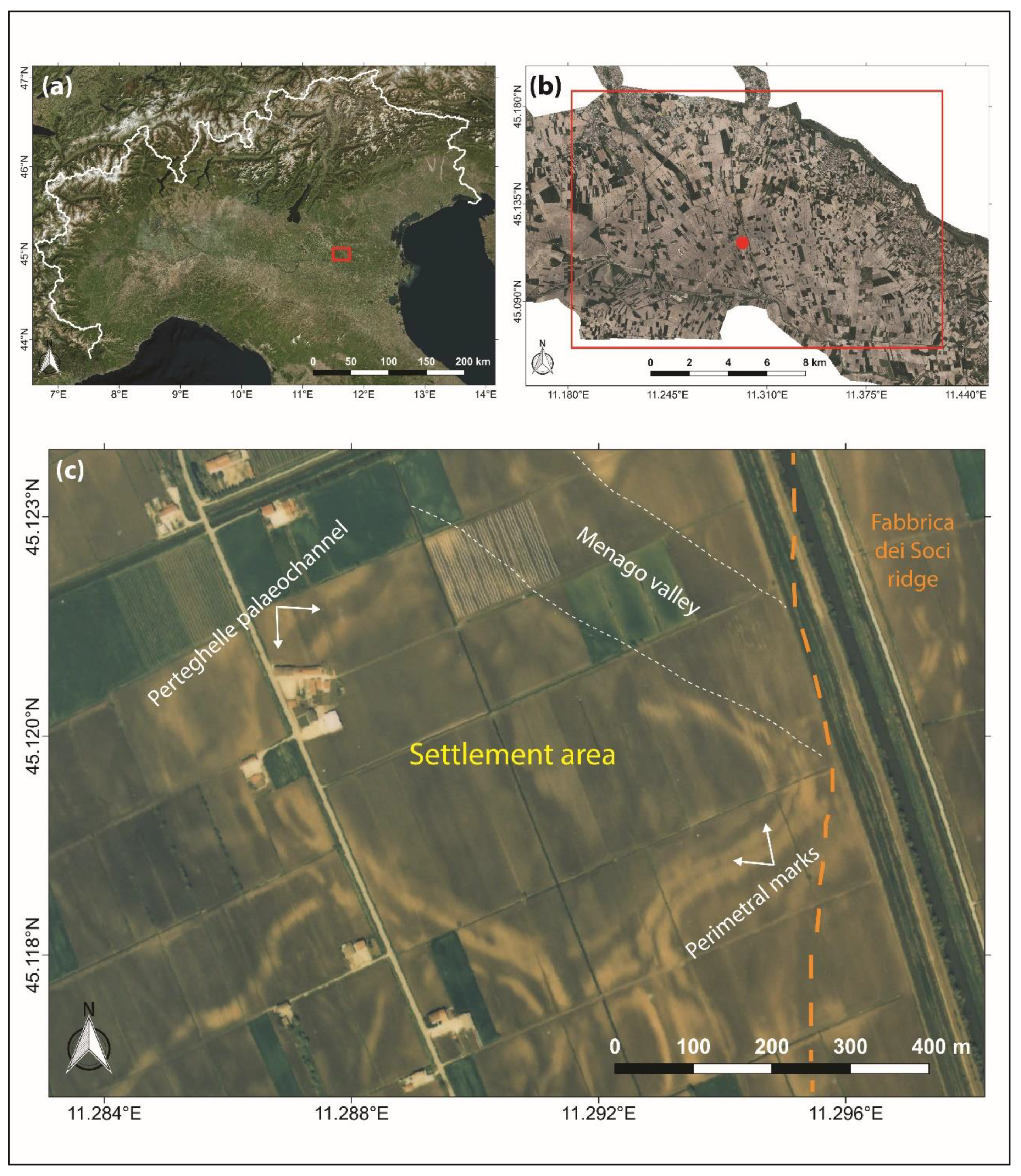

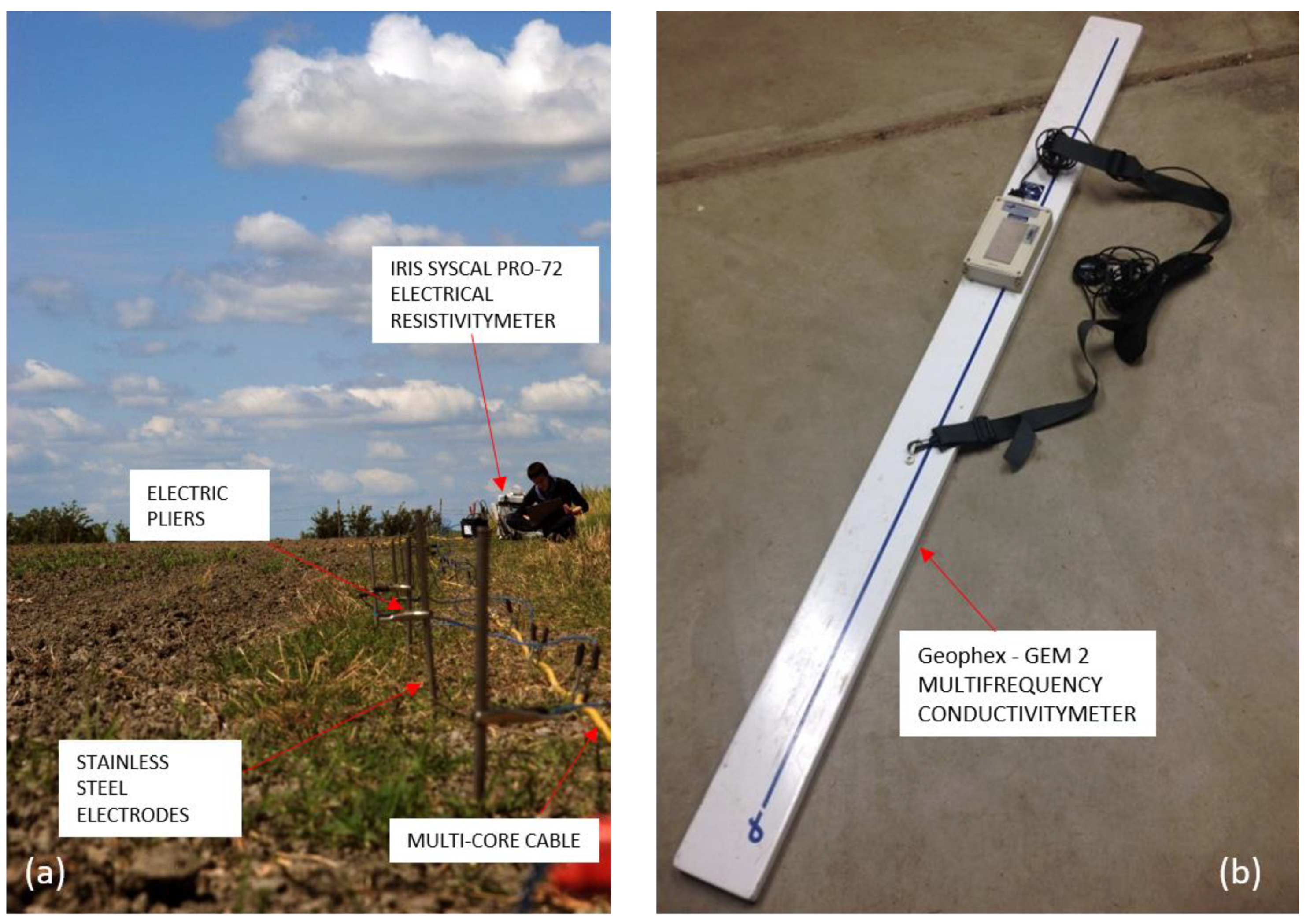
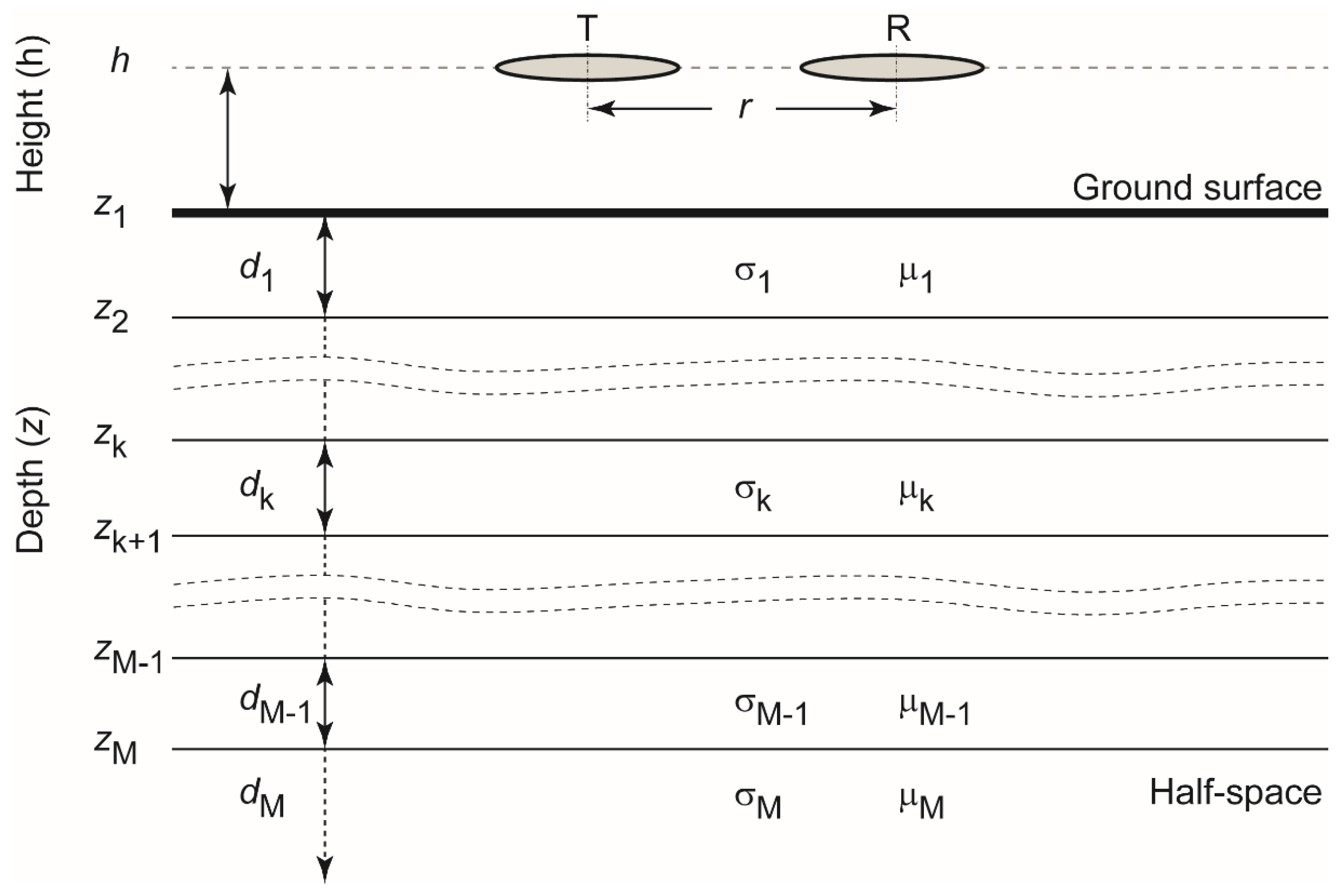
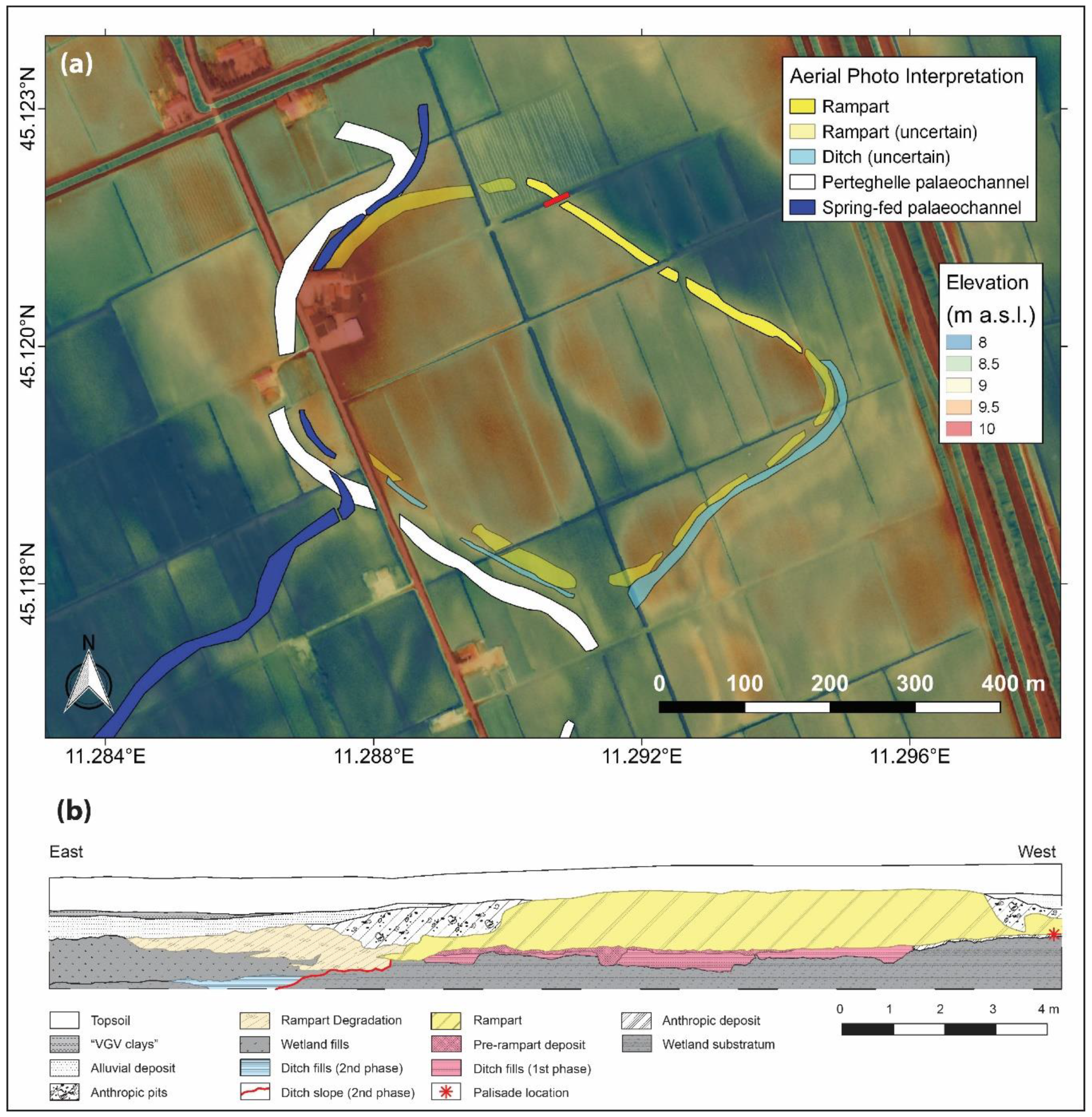

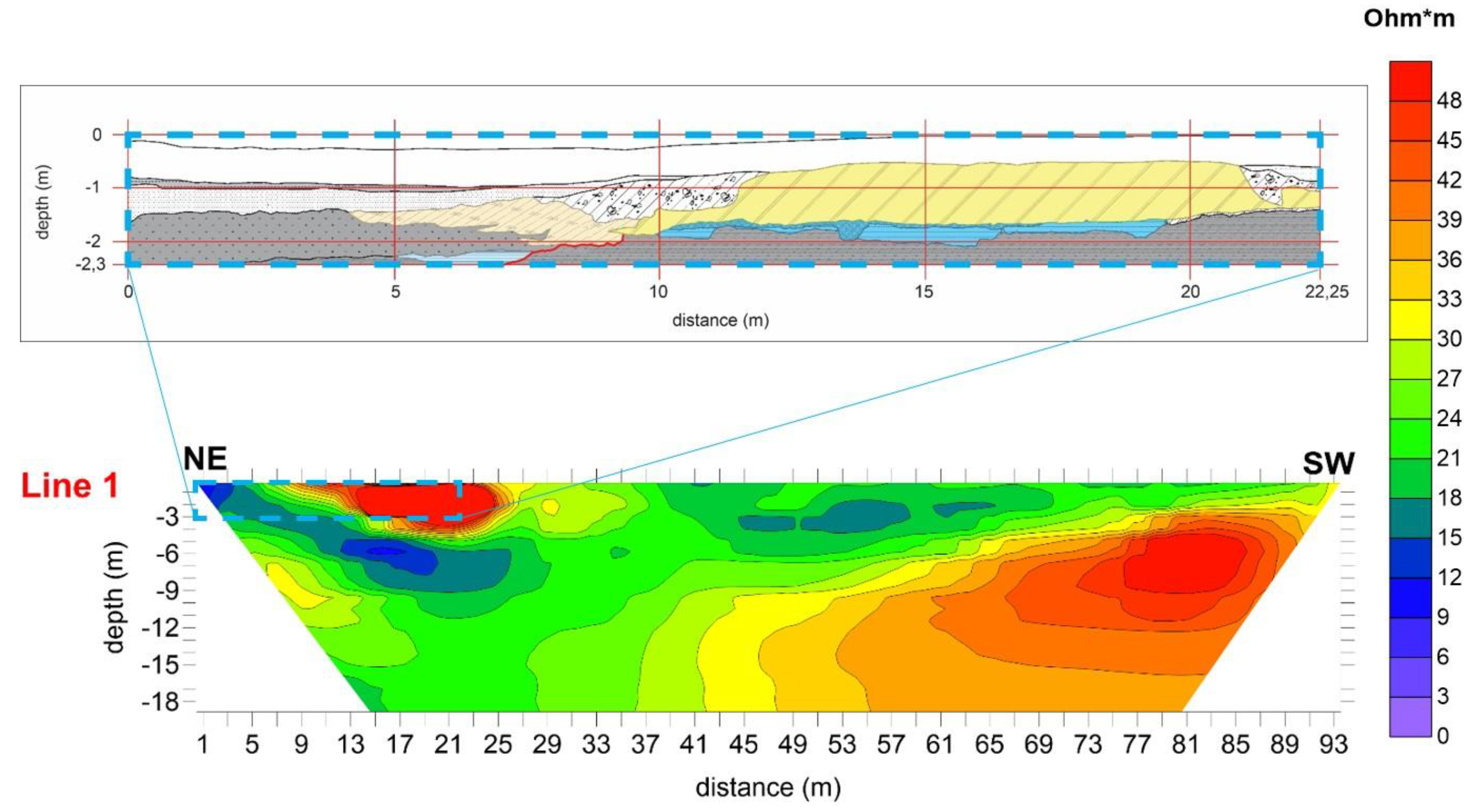

| Flight | Date | Elevation (m a.s.l.) | Focal Length (mm) | Spatial Resolution (Pixels) | Band Spectra Image | Single Frame Codes |
|---|---|---|---|---|---|---|
| IGMI. GAI. | 24 May 1955 | 5000 | 154.17 | 6051 × 5960 (23 × 23 cm photo) | Visible Light (B/W) | VV GAI M 26 AMS; 5276 |
| SCAME. | 16 March 1983 | 2500 | 153.26 | 6000 × 5598 (23 × 23 cm photo) | Visible Light (B/W) | Re.Ven.-VR/2 1983; 12/5070 |
| CGR. | 13 April 1990 | 3000 | 151.77 | 5833 × 5993 (23 × 23 cm photo) | Visible Light (Colors) | Re.Ven. 90; 26A/21 |
| ROSSI | 27 July 1997 | 2500 | 153.04 | 6078 × 5718 (23 × 23 cm photo) | Visible Light (Colors) | Re.Ven.-VR-SUD; 16/89 |
| CGR. | 17 April 1999 | 2500 | 153.26 | 6097 × 5631 (23 × 23 cm photo) | Visible Light (Colors) | Re.Ven. Veneto Prov.Ro 99; 63/1648 |
| CGR. | 26 June 2004 | 2500 | 153.28 | 6218 × 5626 (23 × 23 cm photo) | Visible Light (Colors) | Re.Ven. VR-SUD-1-VOLO-2004; 550 |
© 2020 by the authors. Licensee MDPI, Basel, Switzerland. This article is an open access article distributed under the terms and conditions of the Creative Commons Attribution (CC BY) license (http://creativecommons.org/licenses/by/4.0/).
Share and Cite
Deiana, R.; Vicenzutto, D.; Deidda, G.P.; Boaga, J.; Cupitò, M. Remote Sensing, Archaeological, and Geophysical Data to Study the Terramare Settlements: The Case Study of Fondo Paviani (Northern Italy). Remote Sens. 2020, 12, 2617. https://doi.org/10.3390/rs12162617
Deiana R, Vicenzutto D, Deidda GP, Boaga J, Cupitò M. Remote Sensing, Archaeological, and Geophysical Data to Study the Terramare Settlements: The Case Study of Fondo Paviani (Northern Italy). Remote Sensing. 2020; 12(16):2617. https://doi.org/10.3390/rs12162617
Chicago/Turabian StyleDeiana, Rita, David Vicenzutto, Gian Piero Deidda, Jacopo Boaga, and Michele Cupitò. 2020. "Remote Sensing, Archaeological, and Geophysical Data to Study the Terramare Settlements: The Case Study of Fondo Paviani (Northern Italy)" Remote Sensing 12, no. 16: 2617. https://doi.org/10.3390/rs12162617
APA StyleDeiana, R., Vicenzutto, D., Deidda, G. P., Boaga, J., & Cupitò, M. (2020). Remote Sensing, Archaeological, and Geophysical Data to Study the Terramare Settlements: The Case Study of Fondo Paviani (Northern Italy). Remote Sensing, 12(16), 2617. https://doi.org/10.3390/rs12162617









